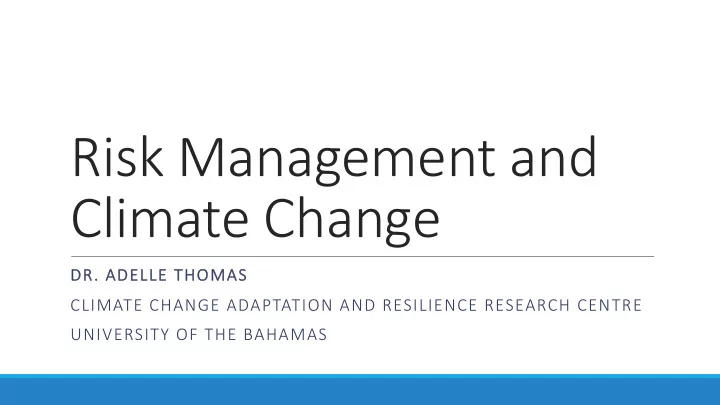

Risk Management and Climate Change DR DR. AD ADELLE TH THOMAS CLIMATE CHANGE ADAPTATION AND RESILIENCE RESEARCH CENTRE UNIVERSITY OF THE BAHAMAS
Hot Topic
What is Risk? Exposure to loss Future from a situation Possibility or uncertainty about affecting a large chance of loss, deviation from group of people danger or injury expected earning or assets or expected outcome
Climate Change Risk HAZARD EXPOSURE VULNERABILITY
HAZARD Hazard Climate-related physical events or trends EXTREME EVENTS SLOW ONSET EVENTS
HAZARD Intensify with increasing global temperatures
HAZARD Ocean warming and acidification Now: Future: • Rate of ocean warming has • Unprecedented conditions doubled • Extensive warming • Marine heatwaves have doubled in • Marine heatwaves 20x more likely frequency, become longer-lasting, and 10x more intense more intense and more extensive • Higher levels of acidification • Oceans have become more acidic
HAZARD Sea level rise projections
EXPOSURE Presence of things of value in places that could be adversely affected
EXPOSURE Spatial and Temporal Dimensions
VULNERABILITY predisposition to be adversely affected; including capacity to cope and adapt Household Level: Species Level: Country Level: • Sensitivity to • Income • GDP/ HDI • Education change • Governance structures • Gender • Ability to migrate • Access to capital • Dependence on • Age • Reliance on particular other species • Social capital sectors
VULNERABILITY Multi-dimensional
Climate Change Risk HAZARD EXPOSURE VULNERABILITY
Comprehensive Risk Management 1. Risk Assessment 2. Risk Reduction 3. Risk Transfer 4. Risk Retention
1. Risk Assessment Establish nature and extent of risk ◦review technical characteristics of hazards ◦Identify exposure of assets ◦Vulnerability assessment
Bahamas: high risk HAZARD Sea level rise, storm surges, flooding, hurricanes, coastal erosion, ocean acidification and warming EXPOSURE Low elevations, population and assets along the coast VULNERABILITY Limited adaptation responses, environmental degradation, development pathways
“The Bahamas is among the top four nations forecast to be hit hardest by rising sea levels… with up to 15 percent of annual GDP and 11 percent of its people in peril.”
2. Risk Reduction Reducing risks through systematic responses ◦Limit exposure ◦Reduce vulnerability STRUCTURAL NON-STRUCTURAL physical construction knowledge, practice or agreements
3. Risk Transfer Shifting consequences of risks to another party ◦insurance
4. Risk Retention Accepting risk and addressing impacts when they occur ◦Contingency funds
Moving forward • Comprehensive risk management at all scales • Widespread climate risk management • Climate Change Adaptation and Resilience Research Centre (CCARR) as a resource
Adelle.Thomas@ub.edu.bs ADELLE_SIDS
Recommend
More recommend